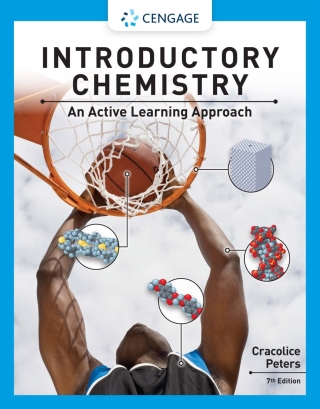Buy Introductory Chemistry: An Active Learning Approach, 7th Edition PDF ebook by author Mark S. Cracolice; Edward I. Peters – published by Cengage Learning in 2021 and save up to 80% compared to the print version of this textbook. With PDF version of this textbook, not only save you money, you can also highlight, add text, underline add post-it notes, bookmarks to pages, instantly search for the major terms or chapter titles, etc.
You can search our site for other versions of the Introductory Chemistry: An Active Learning Approach, 7th Edition PDF ebook. You can also search for others PDF ebooks from publisher Cengage Learning, as well as from your favorite authors. We have thousands of online textbooks and course materials (mostly in PDF) that you can download immediately after purchase.
Note: e-textBooks do not come with access codes, CDs/DVDs, workbooks, and other supplemental items.
eBook Details:
Full title: Introductory Chemistry: An Active Learning Approach, 7th Edition
Edition: 7th
Copyright year: 2021
Publisher: Cengage Learning
Author: Mark S. Cracolice; Edward I. Peters
ISBN: 9780357363935, 9780357363935
Format: PDF
Description of Introductory Chemistry: An Active Learning Approach, 7th Edition:
Teach your course your way with INTRODUCTORY CHEMISTRY: AN ACTIVE LEARNING APPROACH, 7th Edition. This modular, student-friendly resource allows you to tailor the order of chapters to accommodate your needs, not only by presenting topics so they never assume prior knowledge, but also by including any necessary preview or review information needed to learn that topic. The authors’ question-and-answer presentation, which allows students to actively learn chemistry while studying an assignment, is reflected in three words of advice and encouragement repeated throughout the book: “”Learn It Now!”” This updated 7th edition leaves no students behind.Important Notice: Media content referenced within the product description or the product text may not be available in the ebook version.
Table of Contents of Introductory Chemistry: An Active Learning Approach, 7th Edition PDF ebook:
DedicationContents OverviewContentsPrefaceChapter 1: Introduction to Chemistry and Introduction to Active Learning1.1 Introduction to Chemistry: Lavoisier and the Beginning of Experimental Chemistry1.2 Introduction to Chemistry: Science and the Scientific Method1.3 Introduction to Chemistry: The Science of Chemistry Today1.4 Introduction to Active Learning: Learning How to Learn Chemistry1.5 Introduction to Active Learning: Your Textbook1.6 A ChoiceKey TermsQuestions, Exercises, and ProblemsChapter 2: Matter and Energy2.1 What Makes Up the Universe?2.2 Representations of Matter: Models and Symbols2.3 States of Matter2.4 Physical and Chemical Properties and Changes2.5 Pure Substances and Mixtures2.6 Separation of Mixtures2.7 Elements and Compounds2.8 The Electrical Character of Matter2.9 Characteristics of a Chemical Change2.10 Conservation Laws and Chemical ChangeKey TermsFrequently Asked QuestionsConcept-Linking ExercisesSmall-Group Discussion QuestionsQuestions, Exercises, and ProblemsChapter 3: Measurement and Chemical Calculations3.1 How Is Time Measured?3.2 Scientific Notation3.3 Conversion Factors3.4 A Strategy for Solving Quantitative Chemistry Problems3.5 Introduction to Measurement3.6 Metric Units3.7 Significant Figures3.8 Significant Figures in Calculations3.9 Metric-USCS Conversions3.10 Temperature3.11 Proportionality and Density3.12 Thoughtful and Reflective PracticeKey TermsFrequently Asked QuestionsConcept-Linking ExercisesSmall-Group Discussion QuestionsQuestions, Exercises, and ProblemsChapter 4: Introduction to Gases4.1 Are the Gas Giants… Gas Giants?4.2 Characteristics of Gases4.3 A Particulate-Level Explanation of the Characteristics of Gases4.4 Gas Pressure4.5 Charles’s Law: Volume and Temperature4.6 Boyle’s Law: Volume and Pressure4.7 The Combined Gas Law: Volume, Temperature, and PressureKey TermsFrequently Asked QuestionsConcept-Linking ExercisesSmall-Group Discussion QuestionsQuestions, Exercises, and ProblemsChapter 5: Atomic Theory: The Nuclear Model of the Atom5.1 Have the Elements Always Existed?5.2 Dalton’s Atomic Theory5.3 The Electron5.4 The Nuclear Atom and Subatomic Particles5.5 Isotopes5.6 Atomic Mass5.7 The Periodic Table5.8 Elemental Symbols and the Periodic TableKey TermsFrequently Asked QuestionsConcept-Linking ExercisesSmall-Group Discussion QuestionsQuestions, Exercises, and ProblemsChapter 6: Chemical Nomenclature6.1 Is It Soda or Pop or Coke?6.2 Review of Selected Concepts Related to Nomenclature6.3 Formulas of Elements6.4 Compounds Made from Two Nonmetals6.5 Names and Formulas of Monatomic Ions: Group 1A/1 and 2A/2 Metals and the Nonmetals6.6 Names and Formulas of Monatomic Ions: Additional Metals6.7 Formulas of Ionic Compounds6.8 Names of Ionic Compounds6.9 The Nomenclature of Oxoacids6.10 The Nomenclature of Oxoanions6.11 The Nomenclature of Acid Anions6.12 The Nomenclature of Hydrates6.13 Summary of the Nomenclature SystemKey TermsFrequently Asked QuestionsConcept-Linking ExercisesSmall-Group Discussion QuestionQuestions, Exercises, and ProblemsChapter 7: Chemical Formula Relationships7.1 How Do You Weigh Something Too Small to Weigh?7.2 The Number of Atoms in a Formula7.3 Molecular Mass and Formula Mass7.4 Stoichiometric Amount7.5 Molar Mass7.6 Conversion among Mass, Amount in Moles, and Number of Units7.7 Mass Relationships among Elements in a Compound: Percentage Composition by Mass7.8 Empirical Formula of a Compound7.9 Determination of a Molecular FormulaKey TermsFrequently Asked QuestionsConcept-Linking ExercisesSmall-Group Discussion QuestionsQuestions, Exercises, and ProblemsChapter 8: Chemical Reactions8.1 Do Chemical Reactions Occur Outside of Earth?8.2 Evidence of a Chemical Change8.3 Evolution of a Chemical Equation8.4 Balancing Chemical Equations8.5 Interpreting Chemical Equations8.6 Writing Chemical Equations8.7 Combination Reactions8.8 Decomposition Reactions8.9 Single-Replacement Reactions8.10 Double-Replacement Reactions8.11 Summary of Reactions and EquationsKey TermsFrequently Asked QuestionsEquation-Classification ExerciseEquation-Balancing ExerciseSmall-Group Discussion QuestionsQuestions, Exercises, and ProblemsChapter 9: Chemical Change9.1 Why Is Salt Solution Different from Sugar Solution?9.2 Electrolytes and Solution Conductivity9.3 Solutions of Ionic Compounds9.4 Strong and Weak Acids9.5 Net Ionic Equations: What They Are and How to Write Them9.6 Single-Replacement Oxidation-Reduction (Redox) Reactions9.7 Oxidation-Reduction Reactions of Some Common Organic Compounds9.8 Double-Replacement Precipitation Reactions9.9 Double-Replacement Molecule-Formation Reactions9.10 Double-Replacement Reactions That Form Unstable Products9.11 Double-Replacement Reactions with Undissolved Reactants9.12 Other Double-Replacement Reactions9.13 Summary of Net Ionic EquationsKey TermsFrequently Asked QuestionsConcept-Linking ExercisesElectrolyte-Classification ExerciseSmall-Group Discussion QuestionsQuestions, Exercises, and ProblemsChapter 10: Quantity Relationships in Chemical Reactions10.1 Okay, Houston, We’ve Had a Problem Here10.2 Conversion Factors from a Chemical Equation10.3 Mass-Mass Stoichiometry10.4 Percentage Yield10.5 Limiting Reactants: The Problem10.6 Limiting Reactants: Comparison-of-Moles Method10.7 Limiting Reactants: Smaller-Amount Method10.8 Energy10.9 Thermochemical Equations10.10 Thermochemical StoichiometryKey TermsFrequently Asked QuestionsProblem-Classification ExercisesSmall-Group Discussion QuestionsQuestions, Exercises, and ProblemsChapter 11: Atomic Theory: The Quantum Model of the Atom11.1 What Causes the Northern Lights?11.2 Electromagnetic Radiation11.3 The Bohr Model of the Hydrogen Atom11.4 The Quantum Mechanical Model of the Atom11.5 Electron Configuration11.6 Valence Electrons11.7 Trends in the Periodic TableKey TermsFrequently Asked QuestionsConcept-Linking ExercisesSmall-Group Discussion QuestionsQuestions, Exercises, and ProblemsChapter 12: Chemical Bonding12.1 How Did the Chemistry of the Universe Begin?12.2 Monatomic Ions with Noble Gas Electron Configurations12.3 Ionic Bonds12.4 Covalent Bonds12.5 Polar and Nonpolar Covalent Bonds12.6 Multiple Bonds12.7 Atoms That Are Bonded to Two or More Other Atoms12.8 Exceptions to the Octet Rule12.9 Metallic BondsKey TermsFrequently Asked QuestionsConcept-Linking ExercisesSmall-Group Discussion QuestionsQuestions, Exercises, and ProblemsChapter 13: Structure and Shape13.1 How Is Genetic Information Stored in Molecules?13.2 Drawing Lewis Diagrams13.3 Electron-Pair Repulsion: Electron-Pair Geometry13.4 Molecular Geometry13.5 The Geometry of Multiple Bonds13.6 Polarity of Molecules13.7 The Structures of Some Organic Compounds (Optional)Key TermsFrequently Asked QuestionsLewis Diagram Recognition ExercisesSmall-Group Discussion QuestionsQuestions, Exercises, and ProblemsChapter 14: The Ideal Gas Law and Its Applications14.1 How Are Tiny Gas Molecules Capable of Launching a Rocket?14.2 Gases Revisited14.3 Avogadro’s Law14.4 The Ideal Gas Law14.5 The Ideal Gas Equation: Determination of a Single Variable14.6 Gas Density14.7 Molar Volume14.8 Gas Stoichiometry at Standard Temperature and Pressure14.9 Gas Stoichiometry: Molar Volume Method (Option 1)14.10 Gas Stoichiometry: Ideal Gas Equation Method (Option 2)14.11 Volume-Volume Gas StoichiometryKey TermsFrequently Asked QuestionsConcept-Linking ExercisesSmall-Group Discussion QuestionsQuestions, Exercises, and ProblemsChapter 15: Gases, Liquids, and Solids15.1 Does Liquid Water Exist beyond Planet Earth?15.2 Dalton’s Law of Partial Pressures15.3 Properties of Liquids15.4 Types of Intermolecular Forces15.5 Liquid-Vapor Equilibrium15.6 The Boiling Process15.7 Water-An “Unusual” Compound15.8 The Solid State15.9 Types of Crystalline Solids15.10 Energy and Change of State15.11 Energy and Change of Temperature: Specific Heat15.12 Change in Temperature Plus Change of StateKey TermsFrequently Asked QuestionsConcept-Linking ExercisesSmall-Group Discussion QuestionsQuestions, Exercises, and ProblemsChapter 16: Solutions16.1 Are There Earth-Like Oceans on Other Planets?16.2 The Characteristics of a Solution16.3 Solution Terminology16.4 The Formation of a Solution16.5 Factors That Determine Solubility16.6 Solution Concentration: Percentage Concentration by Mass16.7 Solution Concentration: Molarity16.8 Solution Concentration: Molality (Optional)16.9 Solution Concentration: Normality (Optional)16.10 Solution Concentration: A Summary16.11 Dilution of Concentrated Solutions16.12 Solution Stoichiometry16.13 Titration Using Molarity16.14 Titration Using Normality (Optional)16.15 Colligative Properties of Solutions (Optional)Key TermsFrequently Asked QuestionsConcept-Linking ExercisesSmall-Group Discussion QuestionsQuestions, Exercises, and ProblemsChapter 17: Acid-Base (Proton Transfer) Reactions17.1 Is the Existence of Acid Molecules Exclusive to Earth?17.2 The Arrhenius Theory of Acids and Bases (Optional)17.3 The Bronsted-Lowry Theory of Acids and Bases17.4 The Lewis Theory of Acids and Bases (Optional)17.5 Conjugate Acid-Base Pairs17.6 Relative Strengths of Acids and Bases17.7 Predicting Acid-Base Reactions17.8 Acid-Base Reactions and Redox Reactions Compared17.9 The Water Equilibrium17.10 pH and pOH (Integer Values Only)17.11 Non-Integer pH-[H+] and pOH-[OH-] Conversions (Optional)Key TermsFrequently Asked QuestionsConcept-Linking ExercisesSmall-Group Discussion QuestionsQuestions, Exercises, and ProblemsChapter 18: Chemical Equilibrium18.1 What Patterns Characterize Reversible Chemical Equilibrium Reactions?18.2 The Character of an Equilibrium18.3 The Collision Theory of Chemical Reactions18.4 Energy Changes during a Molecular Collision18.5 Conditions That Affect the Rate of a Chemical Reaction18.6 The Development of a Chemical Equilibrium18.7 Le Chatelier’s Principle18.8 The Equilibrium Constant18.9 The Significance of the Value of K18.10 Equilibrium Calculations: An Introduction (Optional)18.11 Equilibrium Calculations: Solubility Equilibria (Optional)18.12 Equilibrium Calculations: Ionization Equilibria (Optional)18.13 Equilibrium Calculations: Gaseous Equilibria (Optional)Key TermsFrequently Asked QuestionsConcept-Linking ExercisesSmall-Group Discussion QuestionsQuestions, Exercises, and ProblemsChapter 19: Oxidation-Reduction (Electron Transfer) Reactions19.1 How Do You Power a Vehicle on the Surface of the Moon?19.2 Electron Transfer Reactions19.3 Voltaic and Electrolytic Cells19.4 Oxidation Numbers and Redox Reactions19.5 Oxidizing Agents and Reducing Agents19.6 Strengths of Oxidizing Agents and Reducing Agents19.7 Predicting Redox Reactions19.8 Redox Reactions and Acid-Base Reactions Compared19.9 Writing Redox Equations (Optional)Key TermsFrequently Asked QuestionsConcept-Linking ExercisesSmall-Group Discussion QuestionsQuestions, Exercises, and ProblemsChapter 20: Nuclear Chemistry20.1 How Did Marie Curie Find Happiness in Difficult Working Conditions?20.2 The Dawn of Nuclear Chemistry20.3 Radioactivity20.4 The Detection and Measurement of Radioactivity20.5 The Effects of Radiation on Living Systems20.6 Half-Life20.7 Natural Radioactive Decay Series-Nuclear Equations20.8 Nuclear Reactions and Ordinary Chemical Reactions Compared20.9 Nuclear Bombardment and Induced Radioactivity20.10 Uses of Radioisotopes20.11 Nuclear Fission20.12 Electrical Energy from Nuclear Fission20.13 Nuclear FusionKey TermsFrequently Asked QuestionsConcept-Linking ExercisesSmall-Group Discussion QuestionsQuestions, Exercises, and ProblemsChapter 21: Organic Chemistry21.1 Are There Organic Molecules in Space?21.2 The Nature of Organic Chemistry21.3 The Molecular Structure of Compounds21.4 Saturated Hydrocarbons: The Alkanes and Cycloalkanes21.5 Unsaturated Hydrocarbons: The Alkenes and Alkynes21.6 Aromatic Hydrocarbons21.7 Summary of the Categories of Hydrocarbons21.8 Sources and Preparation of Hydrocarbons21.9 Chemical Reactions of Hydrocarbons21.10 Uses of Hydrocarbons21.11 Alcohols and Ethers21.12 Aldehydes and Ketones21.13 Carboxylic Acids and Esters21.14 Amines and Amides21.15 Summary of the Organic Compounds of Carbon, Hydrogen, Oxygen, and Nitrogen21.16 Chain-Growth Polymers21.17 Step-Growth PolymersKey TermsFrequently Asked QuestionsConcept-Linking ExercisesSmall-Group Discussion QuestionsQuestions, Exercises, and ProblemsChapter 22: Biochemistry22.1 Is There Life on Other Planets?22.2 Amino Acids and Proteins22.3 Enzymes22.4 Carbohydrates22.5 Lipids22.6 Nucleic AcidsKey TermsFrequently Asked QuestionsConcept-Linking ExercisesSmall-Group Discussion QuestionsQuestions, Exercises, and ProblemsAppendix I: Chemical CalculationsAppendix II: The SI System of UnitsGlossaryIndex





